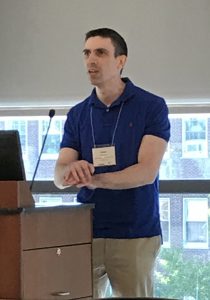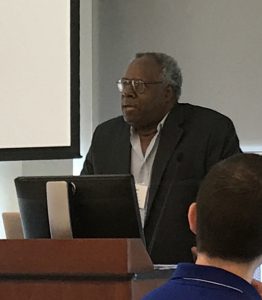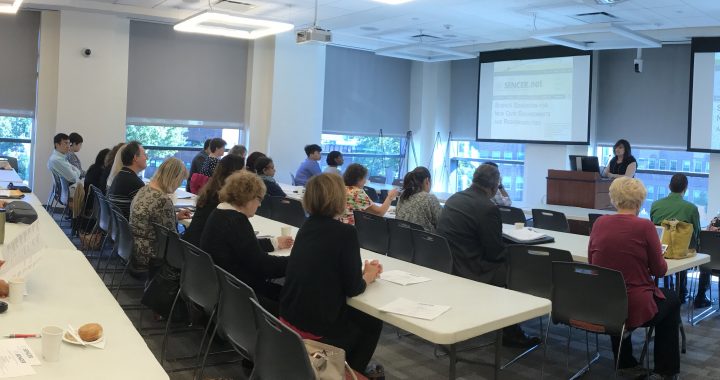by Monica Devanas, SCI-MidAtlantic Co-Director, Rutgers University

Jason Schanker, Molloy College
Molloy College, a gem of a campus in Rockville Centre New York was the host institution for the SCI MidAtlantic Regional Meeting on September 23, last Saturday. Jason Schanker, a second generation SENCER faculty (son of Herb of College of Staten Island) was our host and provided the SENCER and Molloy communities with most gracious accommodations.
Audrey Cohan, Dean of Natural Sciences, Math & Computer Studies, Allied Health Sciences, and Communication Sciences & Disorders, and Jason Schanker greeted and welcomed the assembly of close to fifty faculty and students from Molloy and SENCER institutions. Eliza Reilly, Monica Devanas and Kathy Brown presented overviews of the SENCER Community and NCSCE projects. “The Fourth Industrial Revolution” was the vision that Dave Ferguson shared with us for ways the SENCER approach can help address these current and coming challenges.
SENCER folk and Molloy Faculty enjoyed exchanging ideas and project outcomes, with SENCER participants from as far away as Penn State – Lehigh Valley and East Stroudsburg University. We enjoyed a very comprehensive program with three workshops, fourteen talks and eleven posters.

David Ferguson, Stony Brook University
WORKSHOPS:
Designing and Redesigning an Interdisciplinary Course
- Catherine Duckett and Heide Estes, Monmouth University
What’s Right With You: A Character Development Training for Civility in the Home School and Workplace
- Marjorie Schiering, Molloy College
Evolution: In Vivo and In Silico
- Natalie Hammerman and Anthony Tovolo, Molloy College

Dean Audrey Cohan
SHORT PRESENTATIONS:
Using Civic Engagement to Help Implement the Next Generation Science Standards
- Kathy Browne, Rider University
The Horseshoe Crab K-12 Curriculum Toolbox: A Perfect STEM Network for Learning and Civic Engagement on an International Scale
- John Tanacredi, Molloy College
Citizen/Scientist: Why Citizen Science is an Avenue for a Democratic Classroom
- Mubina Schroeder, Molloy College
STEM Influences in a Humanities Context
- Eliza Reilly, NCSCE, Stony Brook University – SUNY
Student Assessment of Learning Gains in SENCERized Online Biology Course
- Eileen Grodziak and Karen Kackley-Dutt, Pennsylvania State University – Lehigh Valley
Hustle and Flow: Keeping the Curriculum Sound with a Transient Teaching Corps
- Heide Hlawaty, Metropolitan College, Davida Smyth, Mercy College, Joanne Ardovini, Metropolitan College
Coding In English
- Jason Schanker, Molloy College
Promoting Environmental Awareness in Mathematics Courses
- Eugene Galparin, East Stroudsburg University
Creating Individual and Collaborative Code Portfolios using GitHub
- Heather Starkle, United Nations and Santiago Vargas, Stony Brook University
Practice of Scientific Argumentation in Chemistry Laboratories
- Ruomei Gao, Duncan Quarless, Bright Emenike, Judith Lloyd, Margaret Torrell, Jody Cardinal, State University of New York College at Old Westbury, and Mary Emenike, Rutgers University
Increasing the Health Literacy of Science and Pre-Allied Health Science Students With Respect To Current Microbiology Issues
- Julie Trachman, Hostos Community College – CUNY
Civic Engagement and Service Learning in the Molloy Communication Sciences and Disorders Program
- Susan Alimonti, Molloy College
Learning Community Linking Quantitative Reasoning and Human A&P courses: curriculum development and students outcomes
- Anna Rozenboym and Emral Devany, Kingsborough Community College – CUNY
Getting 5th graders interested in STEM through the CSTEP day of service
- Mary Kusenda, Molloy College
POSTER PRESENTATIONS:
Designer Drugs: Societal Issues and Solutions Using Rapid Screening and Quantification with DART-MS and NMR Spectroscopy
- Michael Marino, Molloy College and Ling Huang, Hofstra University
Tracing a Treasured Resource: The Flow and Chemistry of the Campus Stormwater Drainage System
- Dina Scheri & Colin Stiles, Rider University 1st year students
Centennial Lake Fish Population Assessment
- Rachel Periera & Kristina Frattaroli, Rider University 1st year students
Age and Condition of Largemouth Bass in Lake Centennial
- Mickey Bagnato, Rider University student
Using Digital Media to Develop an Understanding of the Scientific Process
- Kathy Browne, Rider University
Engaging Students in the Core Curriculum through a Healthy Neighborhoods Project
- Irene Dabrowski and Roberta Hayes, St. John’s University
Pairing Humanities and the Environmental Sciences: Evaluating Student Impact
- Linden Higgins, Education for Critical Thinking, Heide Estes and Catherin Duckett, Monmouth University
Student Environmental Engagement at the Intersection of Science and Humanities: Using Rubrics and Student Writing to Assess Learning & Validate Self-reported Learning
- Catherine Duckett, Monmouth University, Linden Higgins, Education for Critical Thinking and Hiede Estes, Monmouth University
How do Humans Impact the Microbiome of a Building?
- Natalie Vargas and Davida Smyth, Mercy College
Role of synthetic and natural antimicrobials on quorum sensing mutants of Staphylococcus aureus
- Bien Porconi and Davida Smyth, Mercy College
A Course-based Undergraduate Research Experience (CURE) in General Chemistry I
- Madhavan Narayanan, Joshua Sabatini, Geetha Surendran, Mercy College, Monica Devanas, Rutgers University, and Davida Smyth, Mercy College
Photographs courtesy of Monica Devanas

